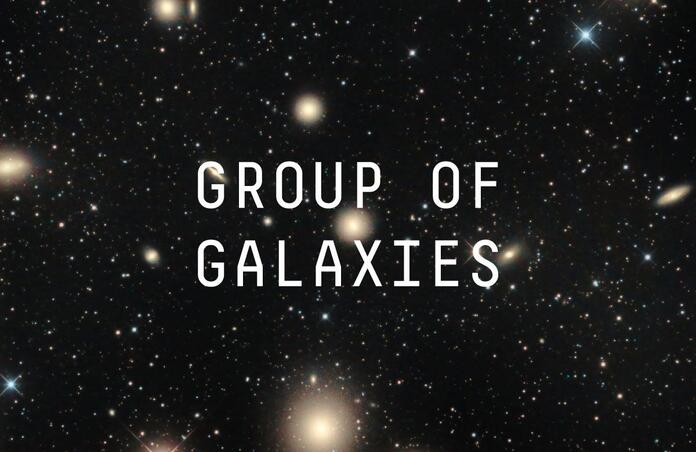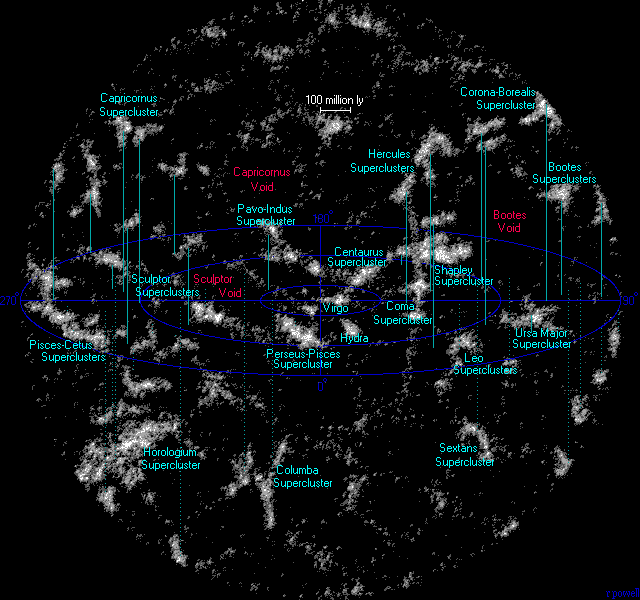What is a galaxy group ?

We’ve looked at individual galaxies’ properties, here we consider their ordering at the cosmic scale.
Over a million Earths can be fitted inside the volume of a typical star like the Sun; billions of stars are contained within one galaxy; tens of galaxies can be bound together in a galaxy group, hundreds to thousands can form a cluster; hundreds of these groups and clusters combined together build superclusters, of which there are about 10 million in the observable Universe. So, galaxy groups are the smallest of these large-scale structures. In 2017, it was decided that what would truly distinguish groups from clusters would not be the number of galaxies, but mass – under 8 × 1013 solar masses it is a group. The diameter of a galaxy group is about 1 to 2 Megaparsec, a distance commonly used in astronomy where 1 parsec corresponds to 3.26 light-years.
Groups in the process of being formed, so-called proto-groups, are embedded in dark matter halos. The rather elusive substance’s repartition can be studied with massive structures like groups and clusters of galaxies, since it only interacts gravitationally with “normal” matter. This is notably done by looking at gravitational lensing, a phenomenon predicted in Einstein’s theory of General Relativity, from which we know that the light from galaxies behind the galaxy group will be distorted, thus allowing astronomers to map dark matter in the group.

The end-stage of a galaxy group’s evolution is known as a fossil group. Due to the gravitational interactions inside the group, galaxies will collide and merge. More precisely, the more massive members of the groups combine into the central galaxy, with possibly some dwarf galaxies remaining intact in the fossil groups. The closest example to us is the elliptical galaxy NGC 6482. But our own galaxy is also part of a galaxy group, the Local Group, and in a few billion years our closest galactic neighbour the Andromeda galaxy will collide and merge with it. The Local Group is part of the larger Virgo Supercluster, with an estimated 47 000 galactic members. In 2014, the existence an even larger gravitationally bound structure containing the Virgo Supercluster as well as other galactic clusters was established, named the Laniakea Supercluster.
Good targets for astrophotography are compact groups, which contain 4-8 galaxies which are very close together (dark matter again plays a significant role here, since the mass needed to explain the holding together of the galaxies is superior than the visible mass of stars and gas). The Hickson Compact Group catalogue references 100 of these compact groups, it is a good place to look if you would like to observe multiple galaxies at once. HCG79 for example contains 2 lenticular galaxies, 2 spiral galaxies and one barred spiral galaxy. One of the lenticular galaxies also shows a tidal tail, a visual reminder of the gravitational interactions inside a galaxy group.
Another catalogue worth mentioning is the Abell Catalogue, which identifies galaxy superclusters. With those targets you will obtain less details for each galaxy than if you observed a compact group.
Cover Image: Group of bright galaxies in Fornax, I. Howart, 10/10/2020 CHI-2
Image credits:
1- Supercluster map of the Universe closest to Earth, R. Powell
2- HGC44, M. Gisiger, 2020 C14 at UCLO
